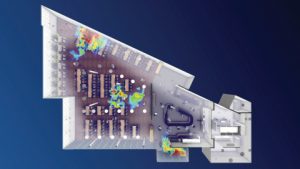As the pandemic continues to challenge the world with new risks and incidences of infection, one way of introducing a solution to buildings and facilities is through smart simulation.
While the coronavirus has inflicted havoc, it has presented a major design challenge to engineers around the world to create solutions, using the very best tools available to them and subsequently curate solutions that help to break the back of the virus. Such solutions lead to the creation of amenable environments that reduce the risk of infection.
Because the coronavirus has been shown to spread through the air via nose and mouth secretions, the physics of airflow and the pathways that contaminated airborne droplets travel help determine designs and layouts to lessen their impact.
Modifying Ventilation
One such solution is to modify ventilation. By placing supplemental ventilation equipment in strategic places within an  existing ventilation system, the pattern of air flow may be strategically altered to divert harmful air particles and increase the rate of exchange of indoor air with fresh air. This is especially true for schools and educational institutions where the classroom environment is close quartered; without altered ventilation, it poses greater risk of virus infection.
existing ventilation system, the pattern of air flow may be strategically altered to divert harmful air particles and increase the rate of exchange of indoor air with fresh air. This is especially true for schools and educational institutions where the classroom environment is close quartered; without altered ventilation, it poses greater risk of virus infection.
For example, as schools and universities prepared to open this past year, an ASHRAE Epidemic Task Force recommended that educational facilities have systems capable of achieving 150 percent of its minimum ventilation air flow to reduce airborne transmission of viruses.
One company, Airxchange Energy Recovery Wheels, was able to offer interchangeable segments with flexibility to modify ventilation systems and reduce air resistance. This resulted in higher ventilation rates.
“Airxchange Energy Recovery Wheels can be provided with our PDX option that reduces air resistance and increased ventilation flow rates,” said Randall Steele, president and CEO of Airxchange. “While the PDX may not be enough to fully attain the ASHRAE recommended 50 percent increase in ventilation rates, it will provide significant improvement with little or no system impact. This is not possible with other manufacturer’s wheels.”
Using Analysis to Modify Facilities
The demand for revised airflow has given rise to using engineering design technology to not only boost flow but also analyze the granularity of air particle movement and flow. The flow may be simulated, and the facility layout may then be altered with extra airflow, such as the case with Airxchange. Or, planners can change seating layouts, modify ventilation, redesignate certain areas within a space, as well as make other modifications to improve the air flow for a safer indoor environment.
Such a scenario lends itself well to digital design tools that operate on a platform such as Dassault Systèmes 3DEXPERIENCE platform. Doing so allows designers to apply iterative designs and simulate different environments to provide a more optimal layout that boosts air exchange and ventilation into a specified area.
Planners and designers may then adopt different layouts and equipment and unfold various options. With such capability they can “flexibly” respond to occupants’ needs. Digital engineering technology tools are put to work, once again, to solve inordinate problems during turbulent times such as a worldwide pandemic.
For example, the German-based firm GEA, one of the largest technology suppliers for the food processing industry,  commissioned SIMULIA applications via the 3DEXPERIENCE platform to simulate airflow in its employee cafeteria in Oelde, Germany. The cafeteria had been closed due to the COVID-19 pandemic.
commissioned SIMULIA applications via the 3DEXPERIENCE platform to simulate airflow in its employee cafeteria in Oelde, Germany. The cafeteria had been closed due to the COVID-19 pandemic.
As a result of the simulation, which provides a remarkable simulation of air droplet pathways, the cafeteria was able to modify cafeteria entrances, exits, as well as various seating layouts. Subsequently, they separated the kitchen area from the seating area, modified the ventilation system, and installed measures to protect kitchen staff.
In GEA’s case, it provided a whole new environment and eased the risk of getting employees back to work. “Simulation provided us with a valuable learning experience and will play a major role in our decision-making as we plan to reopen our cafeteria, which is an important gathering space for all our employees,” said Erich Nitzsche, vice president, Engineering Standards & Services, GEA. “We can be more purposeful in our thinking as we solve problems to ensure the health and safety of our employees and reduce the negative impacts on our business.”
